Healthylifestyle: Cooking Lebanese
Published: Saturday | January 10, 2009

Zucchini, widely used in Lebanese cuisine, can be combined with red bell pepper, tofu, carrot, red onion, mushroom and cherry tomato on a skewer. - Contributed
Lebanon is not a place you may plan to visit just now but if you love exotic foods you will find joy in preparing Lebanese foods at home or enjoying the cuisine while dining out.
Rave reviews about Lebanese foods have moved beyond Mideast borders to become extremely popular in the Western world where rich pastries, milk cakes, tabbouleh and ground mutton in rice with tomatoes are in great demand.
Among Lebanese families worldwide, the culinary tradition is passed from mothers and grandmothers to their children and grandchildren. Lebanese foods date back to biblical times when bread and wine were celebrated by the Jews. The fame of the wine was used to honour a person "his fame shall be like the wine of Lebanon" (Hosea 14:8).
Heart-warming wines
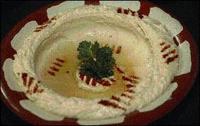
Hummus, chickpea dip with sesame cream, is a Middle Eastern favourite served at Habibi Latino, the St Andrew restaurant. - File
Lebanon is a republic in western Asia, bordered by Syria to the north and east and Israel to the south. Beirut is the capital of Lebanon, a small country about one-fifth the size of Connecticut in the United States. Lebanon is known for its mountains, which parallel the western coastline and cover most of the country.
Between the mountains is the fertile Bekaa valley, home to some of the best vineyards, producing fine wines as a natural complement to Lebanese cuisine.
Health foods
Lebanese cuisine is considered to be healthy, with heavy dependence on grains in bread, bourghol (crushed wheat) and rice. What is also interesting about Lebanese foods is the simple use of fresh vegetables - zucchini, cabbage, artichokes, potatoes and carrots - to create tasty vegetarian specials.
Mint, called n'ana in Arabic, one of the most common herbs in Lebanese cooking, will enliven potato salad. Lebanese pick farm-fresh organic vegetables from their gardens and they cook what they grow. They also store and preserve what they can for future use in home-cooked meals.
Kusa squash
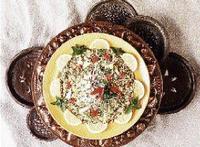
Bulgur, a cracked wheat kernel, can become a remarkable Crab Tabbouleh Salad. Tabbouleh, a salad or side dish made with tomatoes, onions, parley, mint, lemon juice and olive oils, has been an integral part of Middle Eastern cuisine for hundreds of years. - MCT photos
Squash is a member of the gourd family and, though biologically classified as a fruit, it is often used as a vegetable. Squash comes in many forms, sizes and varieties, including the summer crookneck squash and the butternut and turban varieties. Other well-known types of squash include the cushaw and winter crookneck and a common member of the gourd family, the pumpkin.
Squashes are central to Lebanese cooking. Kusa is a type of squash used to make kusa mihshi, a popular Lebanese dish made from squash or zucchini, lamb, brown rice, marjoram, cumin, dried mint, allspice, cayenne pepper and chunky tomato sauce.
Crème custard
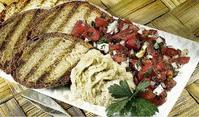
Eggplant has a mild, subtle taste and a smooth, creamy texture. It's popular in many countries. Eggplant is also reasonably priced and will keep fresh in the refrigerator for several days.
Even dessert lovers will find favour in pastry stuffed with walnuts and almonds. A popular dessert is coffee crème caramel in which custard made from low-fat milk, eggs and coffee is placed in a water bath for a smooth texture.
Carrot cake is a traditional favourite and the nutritional content is enhanced with the use of wholewheat flour milled from soft wheat. This contains less gluten and helps to produce a delicate product, while providing more fibre and other nutritional benefits of wholegrain.
Meat lovers can enjoy mutton and beef served up in tasty fusion of herbs and spices. Lebanese cuisine is economical as it utilises everything in the kitchen, including mutton and beef bones to make soup stock. Excess meat is ground to make other dishes and bread is never thrown away. It is toasted or grilled to get dry and crunchy and is eaten as a cracker, or used to create new exciting dishes. If it becomes unfit to use, it is kissed before it is dumped.
Bulgur
A typical Lebanese pantry will have bulgur, a staple grain in Lebanese dishes. Bulgur is made by parboiling, drying and coarsely grinding or cracking wheat berries. The parboiling process allows bulgur to cook easily in any dish by quickly soaking in hot water.
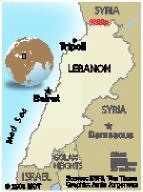
TABBOULEH
A delicious bulgur salad made from tomatoes, scallion (or green onions) and cucumber, seasoned in the traditional way with fresh mint and lemon juice.
1 cup bulgur
3 tomatoes, seeded and chopped
2 cucumbers, peeled and chopped
3 stalks scallion, chopped
3 cloves garlic, minced
1 cup fresh parsley, chopped
1/3 cup fresh mint leaves
2 teaspoons salt (as desired)
1/2 cup lemon juice
2/3 cup extra virgin olive oil
Method
Place bulgur in a bowl and cover with two cups of boiling water. Soak for 30 minutes. Drain and squeeze out excess water. In another bowl, combine the bulgur, tomatoes, cucumbers and remaining ingredients. Toss and refrigerate for at least four hours before serving. Toss again just before serving with crisp lettuce leaves.
Virtues of eggplant
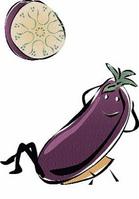
Eggplant comes in oval, elongated or ornamental varieties with small amounts of nutrients. They are naturally low in calories. Unpeeled, they provide some fibre. Eggplant also contains some folate and potassium and is widely used in Lebanese cuisine. Eggplant can be baked, grilled, steamed, or sauteed. Eggplant is versatile and works well with tomatoes, onions, garlic and cheese.
Eggplant is grilled alongside garlic for baba ganouj (or baba ganoush) to create a smoky flavour. Baba ganouj can easily knock the sceptic off his feet. This classic eggplant dip can be served as an appetiser with pita wedges. It is made by placing cubes of eggplant on a skewer and grilled alongside garlic for eight minutes. Both eggplant and garlic are placed in a food processor with lemon juice, tahini and salt and processed until smooth.
Heather Little-White, PhD, is a nutrition and lifestyle consultant in the Corporate Area. Send comments to editor@gleanerjm.com or fax 922-6223.
